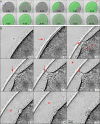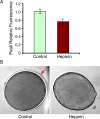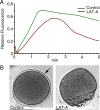Alteration of the cortical actin cytoskeleton deregulates Ca2+ signaling, monospermic fertilization, and sperm entry
- PMID: 18974786
- PMCID: PMC2570615
- DOI: 10.1371/journal.pone.0003588
Alteration of the cortical actin cytoskeleton deregulates Ca2+ signaling, monospermic fertilization, and sperm entry
Abstract
Background: When preparing for fertilization, oocytes undergo meiotic maturation during which structural changes occur in the endoplasmic reticulum (ER) that lead to a more efficient calcium response. During meiotic maturation and subsequent fertilization, the actin cytoskeleton also undergoes dramatic restructuring. We have recently observed that rearrangements of the actin cytoskeleton induced by actin-depolymerizing agents, or by actin-binding proteins, strongly modulate intracellular calcium (Ca2+) signals during the maturation process. However, the significance of the dynamic changes in F-actin within the fertilized egg has been largely unclear.
Methodology/principal findings: We have measured changes in intracellular Ca2+ signals and F-actin structures during fertilization. We also report the unexpected observation that the conventional antagonist of the InsP(3) receptor, heparin, hyperpolymerizes the cortical actin cytoskeleton in postmeiotic eggs. Using heparin and other pharmacological agents that either hypo- or hyperpolymerize the cortical actin, we demonstrate that nearly all aspects of the fertilization process are profoundly affected by the dynamic restructuring of the egg cortical actin cytoskeleton.
Conclusions/significance: Our findings identify important roles for subplasmalemmal actin fibers in the process of sperm-egg interaction and in the subsequent events related to fertilization: the generation of Ca2+ signals, sperm penetration, cortical granule exocytosis, and the block to polyspermy.
Conflict of interest statement
Figures










Similar articles
-
Actin, more than just a housekeeping protein at the scene of fertilization.Sci China Life Sci. 2011 Aug;54(8):733-43. doi: 10.1007/s11427-011-4202-x. Epub 2011 Jul 24. Sci China Life Sci. 2011. PMID: 21786196 Review.
-
Early events of fertilization in sea urchin eggs are sensitive to actin-binding organic molecules.Biochem Biophys Res Commun. 2014 Aug 1;450(3):1166-74. doi: 10.1016/j.bbrc.2014.06.057. Epub 2014 Jun 21. Biochem Biophys Res Commun. 2014. PMID: 24960199
-
Sodium-mediated fast electrical depolarization does not prevent polyspermic fertilization in Paracentrotus lividus eggs.Zygote. 2019 Aug;27(4):241-249. doi: 10.1017/S0967199419000364. Epub 2019 Aug 9. Zygote. 2019. PMID: 31397235
-
The biphasic increase of PIP2 in the fertilized eggs of starfish: new roles in actin polymerization and Ca2+ signaling.PLoS One. 2010 Nov 23;5(11):e14100. doi: 10.1371/journal.pone.0014100. PLoS One. 2010. PMID: 21124897 Free PMC article.
-
Calcium and actin in the saga of awakening oocytes.Biochem Biophys Res Commun. 2015 Apr 24;460(1):104-13. doi: 10.1016/j.bbrc.2015.03.028. Biochem Biophys Res Commun. 2015. PMID: 25998739 Review.
Cited by
-
Effects of Dithiothreitol on Fertilization and Early Development in Sea Urchin.Cells. 2021 Dec 17;10(12):3573. doi: 10.3390/cells10123573. Cells. 2021. PMID: 34944081 Free PMC article.
-
The Effect of Acidic and Alkaline Seawater on the F-Actin-Dependent Ca2+ Signals Following Insemination of Immature Starfish Oocytes and Mature Eggs.Cells. 2023 Feb 25;12(5):740. doi: 10.3390/cells12050740. Cells. 2023. PMID: 36899875 Free PMC article.
-
De novo assembly of a transcriptome from the eggs and early embryos of Astropecten aranciacus.PLoS One. 2017 Sep 5;12(9):e0184090. doi: 10.1371/journal.pone.0184090. eCollection 2017. PLoS One. 2017. PMID: 28873438 Free PMC article.
-
Essential Role of Sperm-Specific PLC-Zeta in Egg Activation and Male Factor Infertility: An Update.Front Cell Dev Biol. 2020 Jan 29;8:28. doi: 10.3389/fcell.2020.00028. eCollection 2020. Front Cell Dev Biol. 2020. PMID: 32064262 Free PMC article. Review.
-
Intersecting roles of protein tyrosine kinase and calcium signaling during fertilization.Cell Calcium. 2013 Jan;53(1):32-40. doi: 10.1016/j.ceca.2012.11.003. Epub 2012 Nov 30. Cell Calcium. 2013. PMID: 23201334 Free PMC article. Review.
References
-
- Dan JC. Studies on the acrosome. II Acrosome reaction in starfish spermatozoa. Biol Bull. 1954;107:203–218.
-
- Dale B, Dan-Sohkawa M, De Santis A, Hoshi M. Fertilization of the starfish Astropecten aurantiacus. Exp Cell Res. 1981;132:505–510. - PubMed
-
- Ikadai H, Hoshi M. Biochemical studies on the acrosome reaction of the starfish Asterias amurensis. I. Factors participating in the acrosome reaction. Dev Growth Diff. 1982;23:73–80. - PubMed
-
- Kyozuka K, Osanai K. Fertilization cone formation in starfish oocytes: the role of the egg cortex actin microfilaments in sperm incorporation. Gamete Res. 1988;20:275–285. - PubMed
-
- Miyazaki S, Hirai S. Fast polyspermy block and activation potential. Correlated changes during oocyte maturation of a starfish. Dev Biol. 1979;70:327–340. - PubMed
Publication types
MeSH terms
Substances
LinkOut - more resources
Full Text Sources
Miscellaneous

